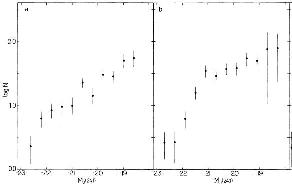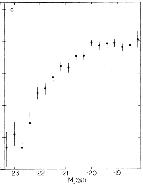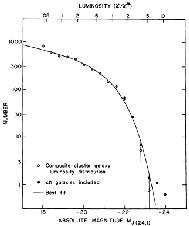


4.3. Luminosity
The first studies on the luminosity function (LF, hereafter) of cluster galaxies aimed at determining the population of cluster galaxies, and, in particular, if dwarf galaxies were clustered like bright galaxies. When Zwicky [512] discovered the missing mass problem, it became very important to evaluate the total cluster luminosity, in order to understand how much of the missing mass could be accounted for by galaxies fainter than the highest observed magnitude, or by diffuse IC light.
In 1931, Carpenter
[95]
analyzed the LF of the newly discovered
Cancer cluster, and noted that it was a steeply rising function at
faint magnitudes, with no maximum. Hubble & Humason
[234] and
Hubble [233],
on the other hand, advocated for a LF with a
maximum around the magnitude
 17. Such a maximum was also
noted by Baade
[34]
in Ursa Major, and by Shapley
[416]
in Coma, but only in the inner region, while the LF
seemed to increase
to fainter magnitudes in the surrounding regions. Such a phenomenology
was later confirmed by Rood & Abell
[384],
and reproduced by
White [491]'s
numerical simulations. White explained the
difference between the inner and outer LFs as an effect of dynamical
friction and merging, leading to an excess of bright galaxies in the
core - see Fig. 24.
Recently, the non-monotonous behaviour of the Coma LF has been
reconsidered [456,
67].
17. Such a maximum was also
noted by Baade
[34]
in Ursa Major, and by Shapley
[416]
in Coma, but only in the inner region, while the LF
seemed to increase
to fainter magnitudes in the surrounding regions. Such a phenomenology
was later confirmed by Rood & Abell
[384],
and reproduced by
White [491]'s
numerical simulations. White explained the
difference between the inner and outer LFs as an effect of dynamical
friction and merging, leading to an excess of bright galaxies in the
core - see Fig. 24.
Recently, the non-monotonous behaviour of the Coma LF has been
reconsidered [456,
67].

|
Figure 25. Abell's estimate of the differential LF of Coma galaxies. From Sky & Telescope (1959). |
In 1951 Zwicky [519] denied the existence of a maximum in the Coma cluster LF. He advocated for a LF rising all the way down the faintest magnitudes reached by observations. This was in agreement with Holmberg [227]'s recent analysis of the LF of the M 81 and M 101 groups, which indicated a considerable fraction of dwarf galaxies. As a matter of fact, the large fraction of dwarf galaxies in the Local Group was already known in the 30's, and clearly at odds with Hubble's Gaussian LF. In the late 50's dwarf galaxies were also found in Virgo (Reaves [366, 367]) and Fornax (Hodge [220, 221]).
In 1959 Abell [8, 9, 10] showed that the cluster LF increased down to a photovisual magnitude of 19.2, despite a secondary maximum around magnitude 15 - see Fig. 25. Two years later Abell [12, 13] analyzed several cluster LFs, and confirmed Zwicky's view of a LF steeply raising down to very faint magnitudes. However, Abell noted the existence of a particular magnitude where the LF changes slope, in disagreement with Zwicky [529], who did not consider the LF secondary maximum to be statistically significant. Abell also explained the apparent Gaussian shape of Hubble's LF as a result of a selection effect.
In 1952 Zwicky [521] first claimed the detection of IC light in Coma. Twenty years later, his finding was confirmed by Welch & Sastry [490]. de Vaucouleurs& de Vaucouleurs [138] showed that most IC light was due to the extended halos of the two central dominant galaxies. They estimated that the IC light accounts for less than 40 % of the total cluster luminosity. Mattila [296] and, independently, Thuan & Kormendy [457] remarked that the blue colour of this IC light suggested it could be originated in dwarf galaxies. Rood et al. [385] had previously estimated that dwarf galaxies could contribute at most 15 % of the total cluster light.
In 1974, Austin & Peach [33] found a secondary maximum in the LF of Abell 1413. This was the second cluster, after Coma, to show a non-monotonous behaviour of its LF. However, three major works put the LF irregularities into oblivion. First, Oemler [331] insisted upon the similarity of the LFs of clusters of different type. However, this is not apparent from Figure 11 in his paper - here reproduced in Fig. 26. Possibly Oemler overlooked differences among the observed LFs, in order to emphasize the overall remarkable similarity with the theoretical mass function recently worked out by Press & Schechter [363]. In their paper, Press & Schechter compared their model to Oemler's LF for Coma, and explained Abell's exponential cut-off magnitude M* as a characteristic feature of the ``self-similar gravitational condensation'' model. Finally, in 1976, Schechter [402] condensed the results of Oemler and Press & Schechter. He built a composite LF from Oemler's data for 13 clusters, and show it to be consistent with a soon-to-be famous ``analytic expression for the luminosity function for galaxies'' - see Fig. 27.

|

|
Figure 26. Composite differential luminosity functions for spiral-rich (panel a), spiral-poor (panel b), cD-clusters (panel c). From Oemler (1974). |

|
Figure 27. Best fit of Schechter's analytic expression to Oemler's observed composite cluster luminosity distribution. From Schechter (1976). |
Schechter's universal LF was readily accepted, probably because it was not purely phenomenological, like the previous ones of Zwicky [525] and Abell [12], but based on Press & Schechter's physical model. Several authors [264, 467] stressed the similarities of the LFs of different clusters and groups. Nonetheless, the numerical simulations of Simon Whit [491] indicated that an evolution of the LF in clusters was expected, because of dynamical friction and merging - see Fig. 24. In the discussion following a talk of Ostriker [337] White remarked upon the similarity of his results and the recent determination of the Coma LF by Godwin & Peach [185]. In 1980, Thompson & Gregory [455] remarked that Schechter's analytic form can fit the LF of all cluster galaxies, but not the LFs of separate morphological classes. In particular, they noted that Hubble's Gaussian LF could provide a good fit to the LF of bright cluster ellipticals. Since different clusters have different fractions of ellipticals, their LFs should be different. The idea of an universal LF was being shattered. Later works [395, 456, 30] confirmed Thompson & Gregory's result. The universality of the LF may still hold within each morphological class separately (e.g. Krupp [264], Andreon [30]).
In 1977 Abell [16] claimed evidence for a steepening of the Coma LF beyond magnitude 17.5. A few years later, Heiligman & Turner [209] noted on the contrary a lack of faint galaxies in compact groups. These two papers anticipated the current discussion on the faint end of the cluster LF [58, 125, 282, 23], which seems to be quite steeper than the field LF [511, 283] (see ANDREON, ULMER, these proceedings). If true, this difference can be explained in the context of Cavaliere et al. [101]'s model for the evolution of galaxies in clusters, a model supported by the observations of Wilson et al. [499].